Slack

The Sumo Logic app for Slack provides monitoring and data analytics for Slack users, channels, access logs for workspaces with free, standard, plus, and enterprise plans. The app is focused on public channels only.
Slack is a cloud-based set of software tools and online services that provide for secure collaboration across teams, departments, offices, and countries.
Log types
Slack logs are in JSON format. The Slack app utilizes the following log types:
Sumo Logic’s Slack collector enhances the logs by adding a few metadata fields so the raw logs from Slack APIs might differ in format. The availability of all types of logs is determined by the slack plans.
| Log Type | Free plan | Standard plan | Plus plan | Enterprise plan |
|---|---|---|---|---|
| User logs | ✓ | ✓ | ✓ | ✓ |
| Public Channel logs | ✓ | ✓ | ✓ | ✓ |
| Public Message logs | ✓ | ✓ | ✓ | ✓ |
| Access logs | ✓ | ✓ | ✓ | |
| Audit logs | ✓ |
Sample log messages
The following table provides sample log messages for the different log types.
User logs
{
"id": "UM27LNGHK",
"name": "test",
"deleted": false,
"real_name": "test",
"tz": "Asia/Kolkata",
"tz_label": "India Standard Time",
"is_admin": false,
"is_owner": false,
"is_primary_owner": false,
"is_restricted": false,
"is_ultra_restricted": false,
"is_bot": false,
"is_app_user": false,
"updated": 1565005724,
"has_2fa": false,
"teamName": "TestSlack",
"email": "test@test.com",
"billable": true,
"logType": "UserLog"
}
Public Channel logs
{
"channel_id": "CKN1D8010",
"channel_name": "testchannel",
"members": 2,
"logType": "ChannelDetail",
"teamName": "TestSlack"
}
Public Message logs
{
"type": "message",
"text": "Test",
"files": [
{
"name": "Test",
"fileType": "epub",
"fileSize": 1258,
"urlPrivate": "https://files.slack.com/files-pri/TJ...htyhomsdconmps",
"urlPrivateDownload": "https://files.slack.com/files-pri/TJ...htyhomsdconmps",
"permalink": "https://testslack-xj11408.slack.com/...htyhomsdconmps"
}
],
"attachments": [
{
"id": 16,
"text": "Test",
"author_name": "",
"author_link": "",
"pretext": "",
"fallback": "Messages Sent"
}
],
"upload": true,
"user": "e65b0bd8",
"display_as_bot": false,
"ts": "1566215592",
"client_msg_id": "23849274-580c-4644-9478-8328e5716b89",
"userName": "roy",
"channelId": "e65b0d0e",
"channelName": "app-for-slack",
"teamName": "TestSlack",
"logType": "ConversationLog"
}
Access logs
{
"user_id": "e65b0476",
"username": "dave",
"date_first": 1566215532,
"date_last": 1566215532,
"count": 2,
"ip": "213.14.129.105",
"user_agent": "Mozilla/5.0 (Windows NT 6.2) AppleWebKit/537.36 (KHTML, like Gecko) Chrome/28.0.1467.0 Safari/537.36",
"isp": "Inetbroadband",
"country": "PA",
"region": "EU",
"teamName": "TestSlack",
"logType": "AccessLog"
}
Audit logs
{
"logType": "UserAuditLog",
"id": "bdcb13e3-28a3-41f0-9ace-a20952def3a0",
"date_create": 1566215192,
"action": "user_created",
"actor": {
"type": "user",
"user": {
"id": "e65b0f5c",
"name": "roy",
"email": "aaron@demo.com"
}
},
"entity": {
"id": "e65b107e",
"privacy": "public",
"name": "BigCo ISP",
"is_shared": false,
"is_org_shared": false,
"filetype": "text/csv",
"title": "john",
"is_distributed": false,
"is_directory_approved": false,
"scopes": [
"identify",
"bot",
"incoming-webhook",
"channels:read",
"groups:read",
"im:read",
"users:read",
"chat:write:bot",
"users:read.email",
"groups:write",
"channels:write",
"team:read",
"chat:write:user"
]
},
"context": {
"location": {
"type": "workspace",
"id": "e65b11aa",
"name": "Docker",
"domain": "Docker"
},
"ua": "Mozilla/5.0 (Windows NT 6.1; Win64; x64; rv:23.0) Gecko/20131011 Firefox/23.0",
"ip_address": "120.188.0.246"
},
"details": {
"id": "USLACKUSER",
"name": "himanshu",
"email": "kumar@demo.com"
}
}
Sample queries
The sample query is from the Channel Summary panel of Slack - Public Channels dashboard.
_sourceCategory=Labs/slack
| join ("logType":"channelDetail"
| json "channel_name", "channel_id", "teamName", "members" as Channel, ChannelId, Workspace, Members
| withtime Members
| most_recent(Members_withtime) as Members by Channel, ChannelId, Workspace) as T1,("logType":"ConversationLog" | json "user", "userName", "type", "subtype", "ts", "text", "channelId", "channelName", "teamName" as ID, User, Type, SubType, Time, Text, ChannelId, Channel, Workspace nodrop
| count_distinct(Time) as Messages by ID, ChannelId, Workspace) as T2 on T1.ChannelId = T2.ChannelId and T1.Workspace=T2.Workspace
| T2_Workspace as Workspace | T2_ID as User| T1_Channel as Channel
| where Workspace matches {{Workspace}} and Channel matches {{Channel}}
| T1_Members as %"Team Members"
| fields Workspace, Channel, User, %"Team Members" ,T2_Messages
| where [subquery:"logType":"UserLog"
| json "id", "name", "deleted", "is_bot", "teamName" as User, Name, Deleted, Bot, Workspace nodrop
| where Bot matches "false" and !(Name matches "slackbot") and Deleted matches "false"
| withtime Name
| most_recent(Name_withtime) as Name by User, Workspace
| compose User, Workspace]
| sum(T2_Messages) as %"Total Messages", count_distinct(User) as %"Members Posted Messages" by Workspace, Channel, %"Team Members"
| fields Workspace, Channel, %"Team Members", %"Total Messages", %"Members Posted Messages"
| sort by %"Total Messages"
| limit 20
Collection configuration and app installation
Depending on the set up collection method, you can configure and install the app in three ways:
- Create a new collector and install the app. Create a new Sumo Logic Cloud-to-Cloud (C2C) source under a new Sumo Logic Collector and later install the app, or
- Use an existing collector and install the app. Create a new Sumo Logic Cloud-to-Cloud (C2C) source under an existing Sumo Logic Collector and later install the app, or
- Use existing source and install the app. Use your existing configured Sumo Logic Cloud-to-Cloud (C2C) source and install the app.
Use the Cloud-to-Cloud Integration for Slack to create the source and use the same source category while installing the app. By following these steps, you can ensure that your Slack app is properly integrated and configured to collect and analyze your Slack data.
Create a new collector and install the app
To set up collection and install the app, do the following:
Next-Gen App: To install or update the app, you must be an account administrator or a user with Manage Apps, Manage Monitors, Manage Fields, Manage Metric Rules, and Manage Collectors capabilities depending upon the different content types part of the app.
- Select App Catalog.
- In the 🔎 Search Apps field, run a search for your desired app, then select it.
- Click Install App.
note
Sometimes this button says Add Integration.
- In the Set Up Collection section of your respective app, select Create a new Collector.
- Collector Name. Enter a Name to display the Source in the Sumo Logic web application. The description is optional.
- Timezone. Set the default time zone when it is not extracted from the log timestamp. Time zone settings on Sources override a Collector time zone setting.
- (Optional) Metadata. Click the +Add Metadata link to add a custom log Metadata Fields. Define the fields you want to associate, each metadata field needs a name (key) and value.
A green circle with a checkmark is shown when the field exists and is enabled in the Fields table schema.
An orange triangle with an exclamation point is shown when the field doesn't exist, or is disabled, in the Fields table schema. In this case, an option to automatically add or enable the nonexistent fields to the Fields table schema is provided. If a field is sent to Sumo that does not exist in the Fields schema or is disabled it is ignored, known as dropped.
- Click Next.
- Configure the source as specified in the
Infobox above, ensuring all required fields are included. - In the Configure section of your respective app, complete the following fields.
- Field Name. If you already have collectors and sources set up, select the configured metadata field name (eg _sourcecategory) or specify other custom metadata (eg: _collector) along with its metadata Field Value.
- Click Next. You will be redirected to the Preview & Done section.
Post-installation
Once your app is installed, it will appear in your Installed Apps folder, and dashboard panels will start to fill automatically.
Each panel slowly fills with data matching the time range query received since the panel was created. Results will not immediately be available but will be updated with full graphs and charts over time.
Use an existing collector and install the app
To set up the source in the existing collector and install the app, do the following:
Next-Gen App: To install or update the app, you must be an account administrator or a user with Manage Apps, Manage Monitors, Manage Fields, Manage Metric Rules, and Manage Collectors capabilities depending upon the different content types part of the app.
- Select App Catalog.
- In the 🔎 Search Apps field, run a search for your desired app, then select it.
- Click Install App.
note
Sometimes this button says Add Integration.
- In the Set Up Collection section of your respective app, select Use an existing Collector.
- From the Select Collector dropdown, select the collector that you want to set up your source with and click Next.
- Configure the source as specified in the
Infobox above, ensuring all required fields are included. - In the Configure section of your respective app, complete the following fields.
- Field Name. If you already have collectors and sources set up, select the configured metadata field name (eg _sourcecategory) or specify other custom metadata (eg: _collector) along with its metadata Field Value.
- Click Next. You will be redirected to the Preview & Done section.
Post-installation
Once your app is installed, it will appear in your Installed Apps folder, and dashboard panels will start to fill automatically.
Each panel slowly fills with data matching the time range query received since the panel was created. Results will not immediately be available but will be updated with full graphs and charts over time.
Use an existing source and install the app
To skip collection and only install the app, do the following:
Next-Gen App: To install or update the app, you must be an account administrator or a user with Manage Apps, Manage Monitors, Manage Fields, Manage Metric Rules, and Manage Collectors capabilities depending upon the different content types part of the app.
- Select App Catalog.
- In the 🔎 Search Apps field, run a search for your desired app, then select it.
- Click Install App.
note
Sometimes this button says Add Integration.
- In the Set Up Collection section of your respective app, select Skip this step and use existing source and click Next.
- In the Configure section of your respective app, complete the following fields.
- Field Name. If you already have collectors and sources set up, select the configured metadata field name (eg _sourcecategory) or specify other custom metadata (eg: _collector) along with its metadata Field Value.
- Click Next. You will be redirected to the Preview & Done section.
Post-installation
Once your app is installed, it will appear in your Installed Apps folder, and dashboard panels will start to fill automatically.
Each panel slowly fills with data matching the time range query received since the panel was created. Results will not immediately be available but will be updated with full graphs and charts over time.
Viewing Slack dashboards
All dashboards have a set of filters that you can apply to the entire dashboard. Use these filters to drill down and examine the data to a granular level.
- You can change the time range for a dashboard or panel by selecting a predefined interval from a drop-down list, choosing a recently used time range, or specifying custom dates and times. Learn more.
- You can use template variables to drill down and examine the data on a granular level. For more information, see Filtering Dashboards with Template Variables.
- Most Next-Gen apps allow you to provide the scope at the installation time and are comprised of a key (
_sourceCategoryby default) and a default value for this key. Based on your input, the app dashboards will be parameterized with a dashboard variable, allowing you to change the dataset queried by all panels. This eliminates the need to create multiple copies of the same dashboard with different queries.
Overview
The Slack - Overview dashboard provides an at-a-glance view of the number of workspaces, members, bots, admins, public channels, and public messages. Panels also show geographic access locations, and key statistics around public messages and files.
Use this dashboard to:
- Monitor the admins, bots, and members across workspaces.
- Identify the trends around public messages and files shared.
- Monitor locations from which workspaces are being accessed.
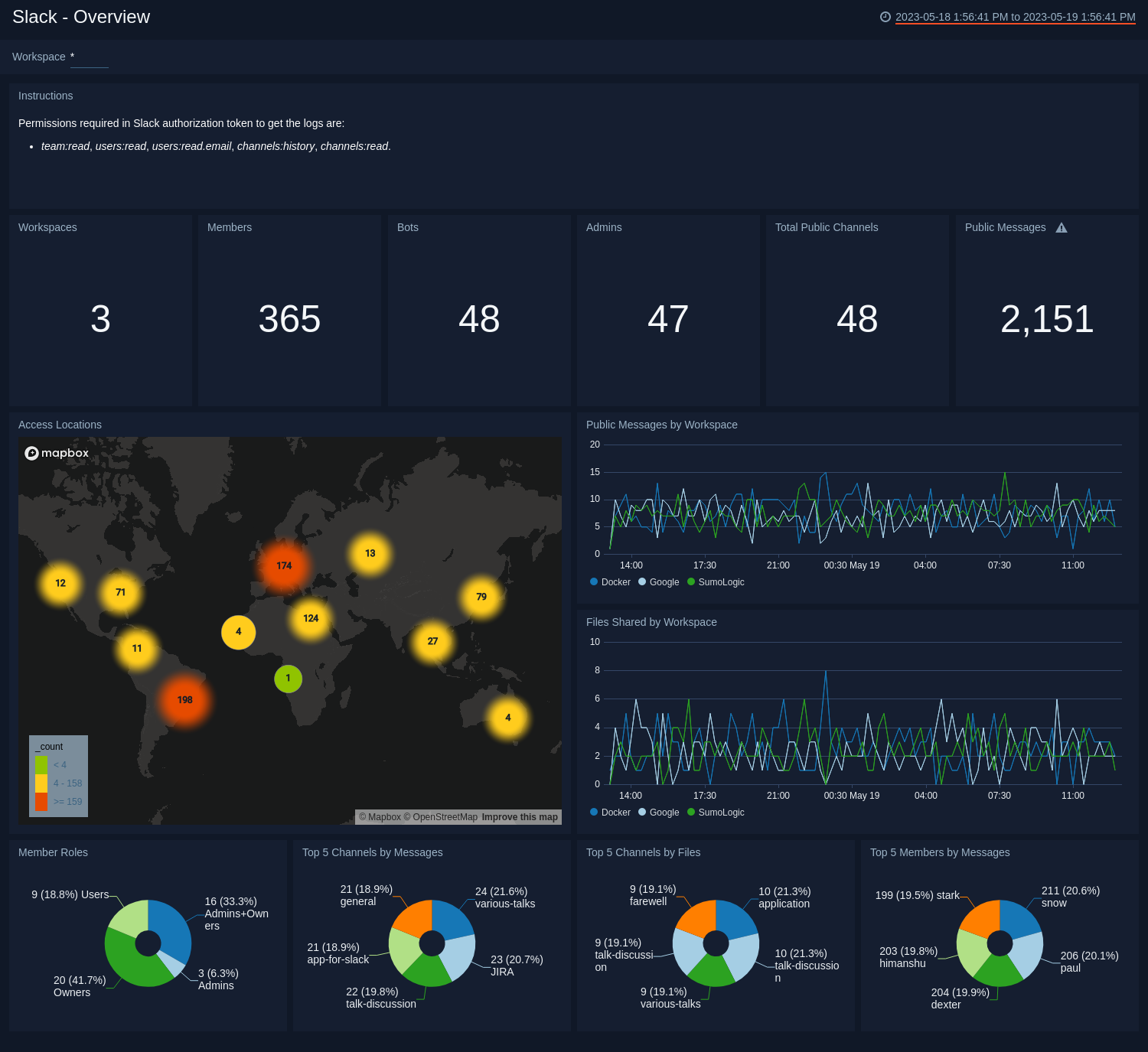
Members
The Slack - Members dashboard shows trends for total members, active members, and messages by workspace. Panels also show detailed member information, and breakdowns by workspace for roles, timezones, and two factor authentication (2FA).
Use this dashboard to:
- Monitor member activity across workspaces.
- Identify inactive members that have not accessed the workspace.
- Identify members that do not have two factor authentication enabled.
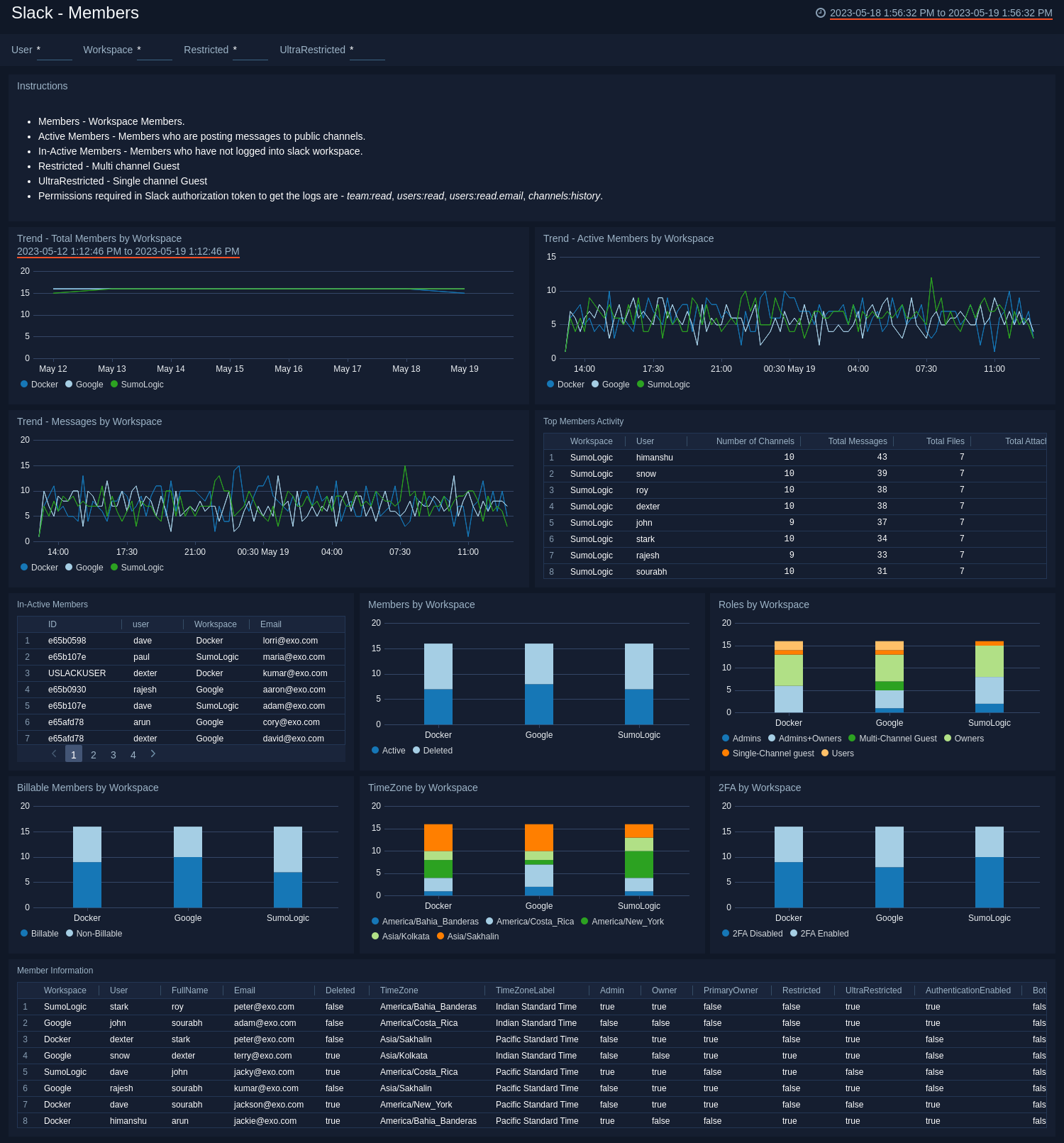
Bots
The Slack - Bots dashboard displays information on bots, which are software applications that run automated tasks over the Internet. Panels show trends by workspace for all bots, active bots, and messages, as well as detailed information on bots, and a detailed bot summary.
Use this dashboard to:
- Monitor bots and bot activities across multiple workspaces.
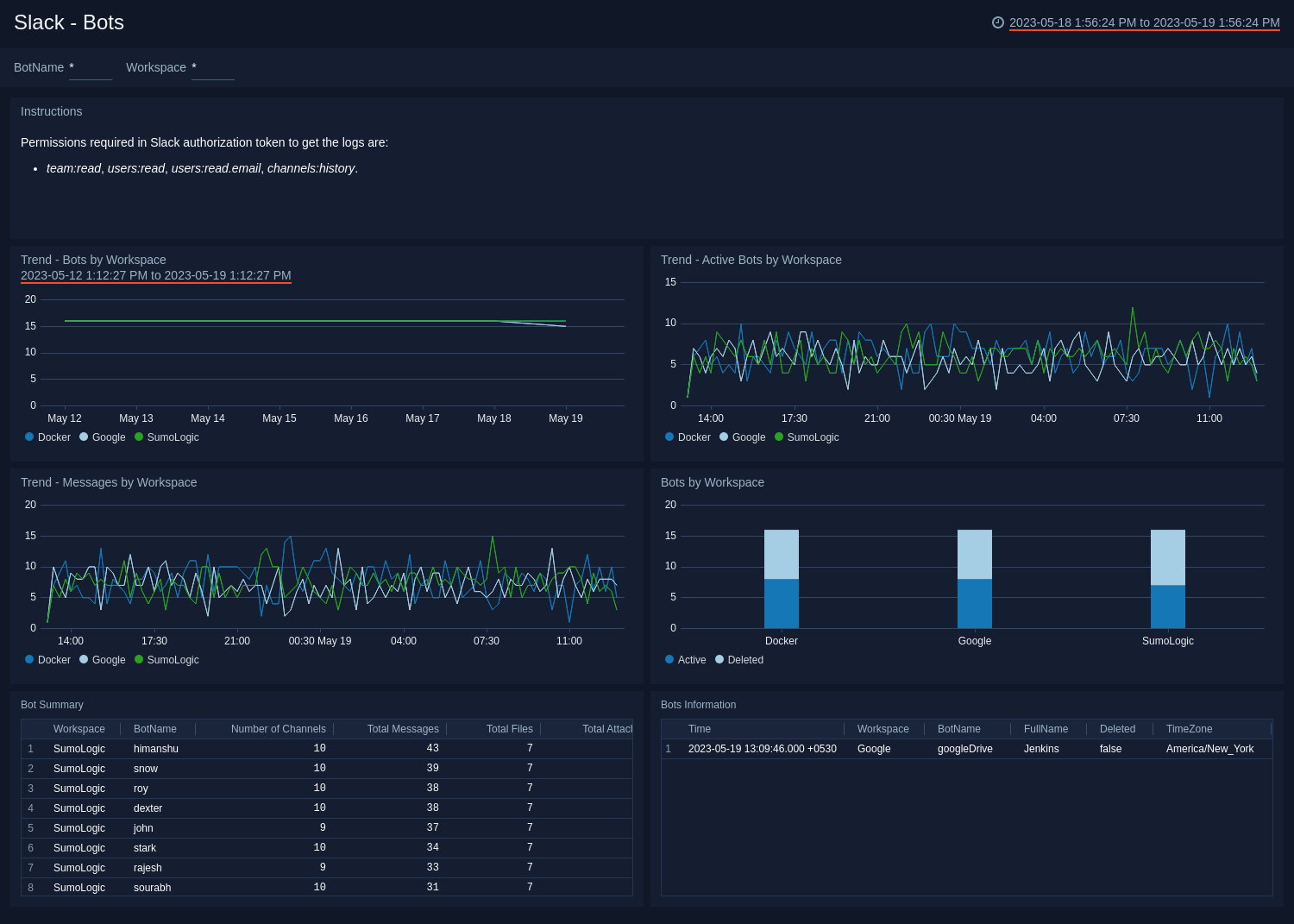
Public Channels
The Slack - Public Channels dashboard provides detailed information across all channels, as well as active channels. Panels also show information on the top ten channels by files and by attachments, and a summary of all channels.
Use this dashboard to:
- Monitor channel activity across multiple workspaces.
- Identify inactive channels where messages are not being posted.
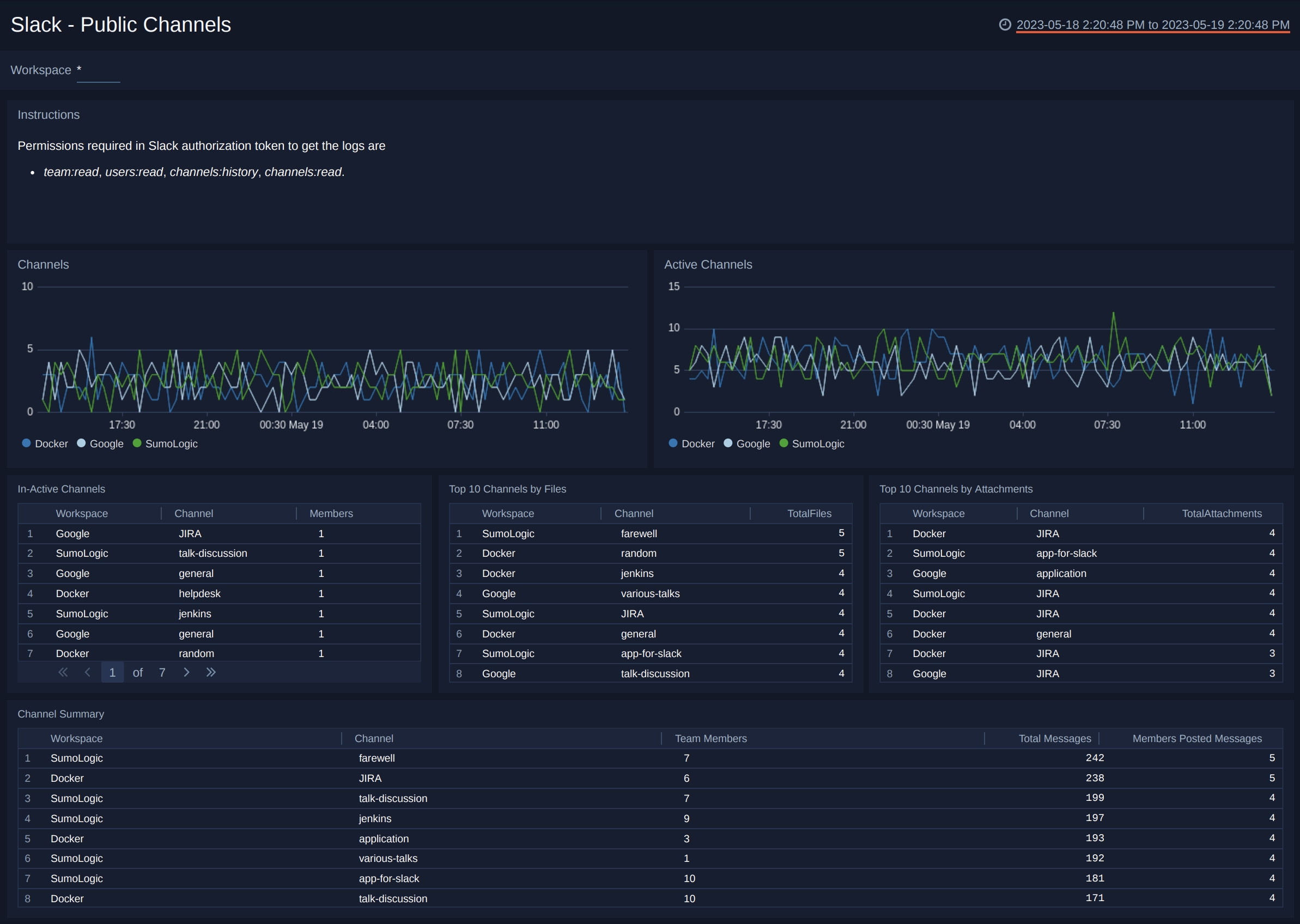
Public Messages
The Slack - Public Messages dashboard provides details around attachments, files shared and statistics around messages in Slack public channels.
Use this dashboard to:
- Monitor various file types being shared and identify those that pose the greatest risk.
- Investigate the details of file shared via the URL links in the Recent File Shared panel.
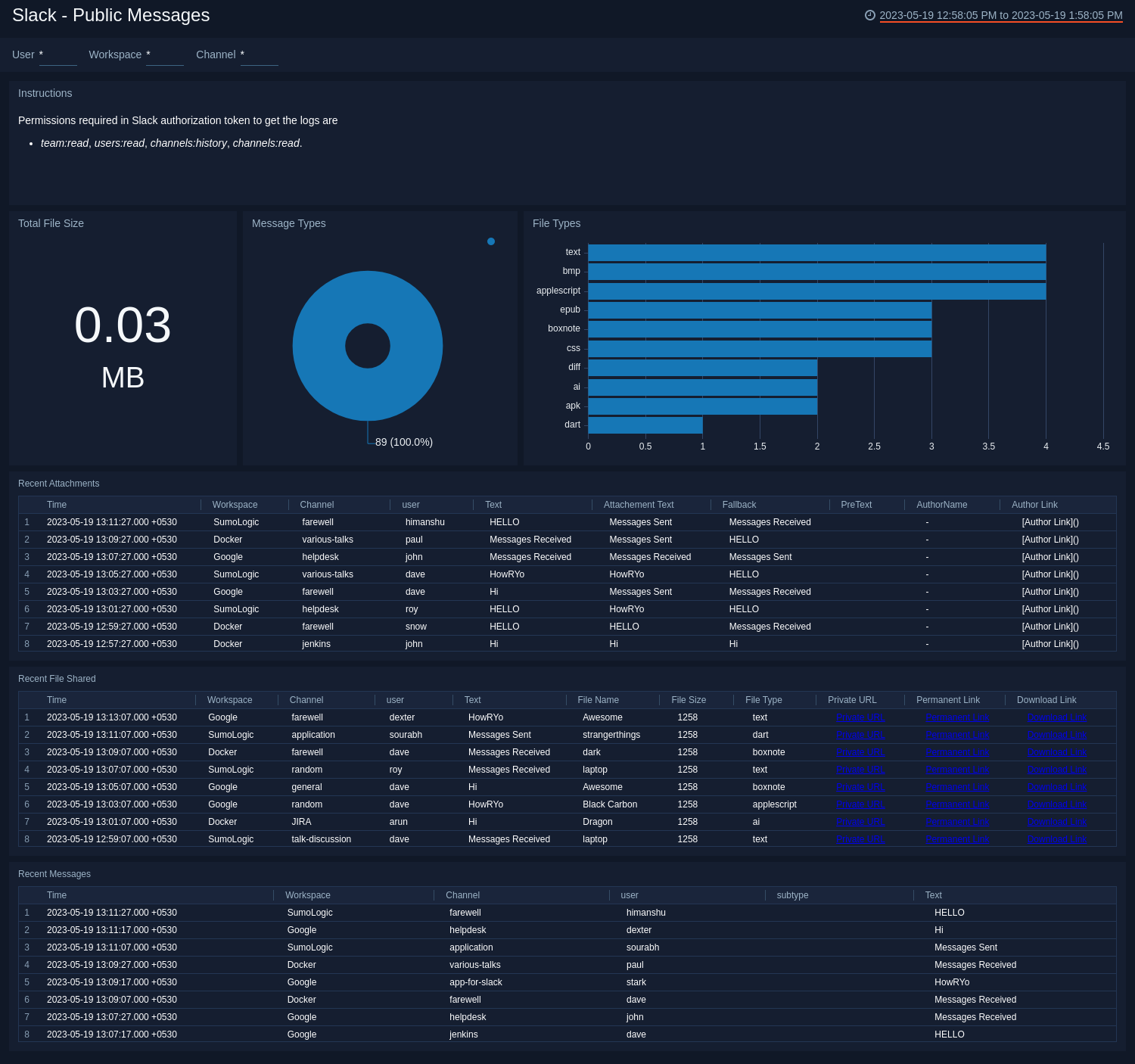
Access
The Slack - Access dashboard helps you monitor how users are accessing Slack and identifies access requests coming in from malicious domains.
Use this dashboard to:
- Identify all incoming threats detected via Sumo Logic Threat Intel.
- Identify the kinds of mobile or desktop platforms that users are using to access Slack.
- Identify trends for user access patterns across multiple workspaces.

Audit Overview Dashboard
The Slack - Audit Overview dashboard provides details around Slack audit actions, and trends.
Use this dashboard to:
- Review audit actions and determine which are not approved or need to be corrected.
- Identify and validate that top users performing audit actions.

User Audit
The Slack - User Audit dashboard provides insight into user and administrative audit actions and trends. Panels also display detailed information for members and guest members.
Use this dashboard to:
- Monitor audit actions across multiple workspaces.
- Monitor all role changes for workspaces and identify any suspicious behavior.
- Monitor and validate that all guest activities are in line with what is expected.
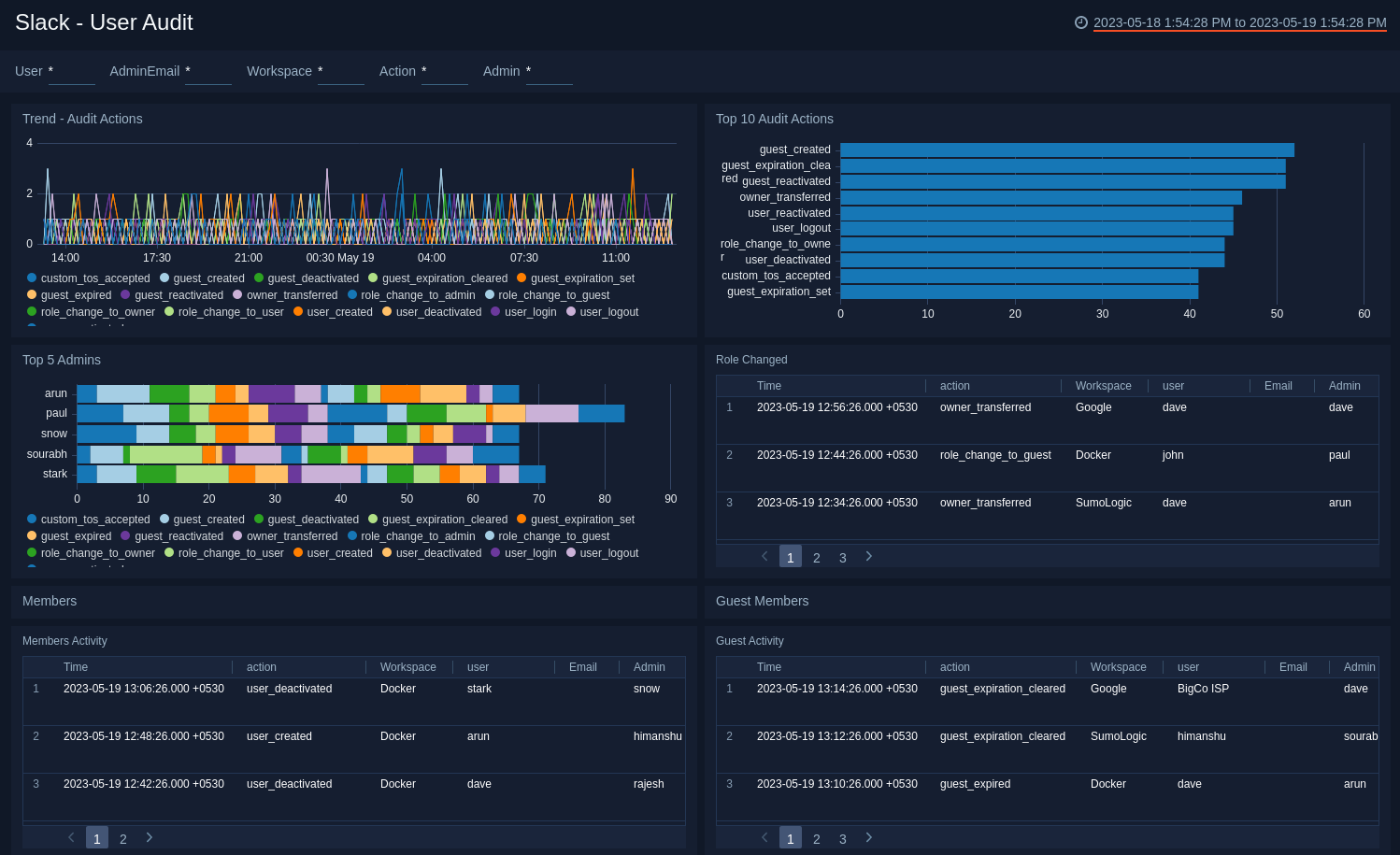
Workspace Audit
The Slack - Workspace Audit dashboard provides information on top users, top audit actions and audit trends. Panels also detail workspace sign on, exports, data retention and billing, and other admin activities.
Use this dashboard to:
- Monitor all workspace related activities.
- Monitor changes to single-sign-on settings including two factor authentication.
- Monitor workspace related, data retention, or billing activities.
- Monitor the exports that are performed on workspaces.
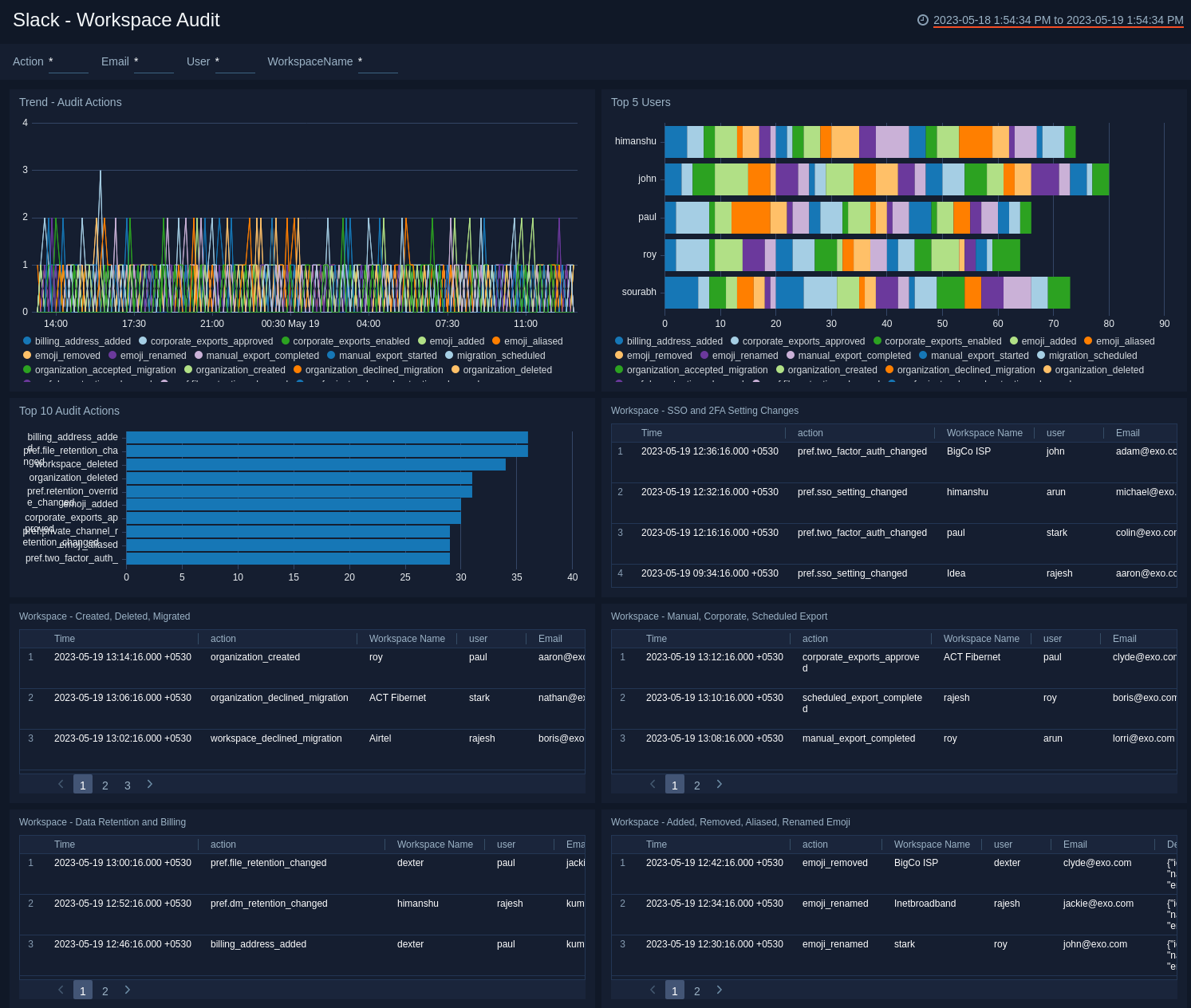
Channel Audit
The Slack - Channel Audit dashboard provides details on the top channel audit actions and trends. The panels also display information on top members and member activity, and top guest members and guest member activity.
Use this dashboard to:
- Monitor channel related activities for multiple workspaces.
- Monitor all the private and public channels joined by members and guests.
- Monitor all the private channels that are created, deleted, and archived by guests.
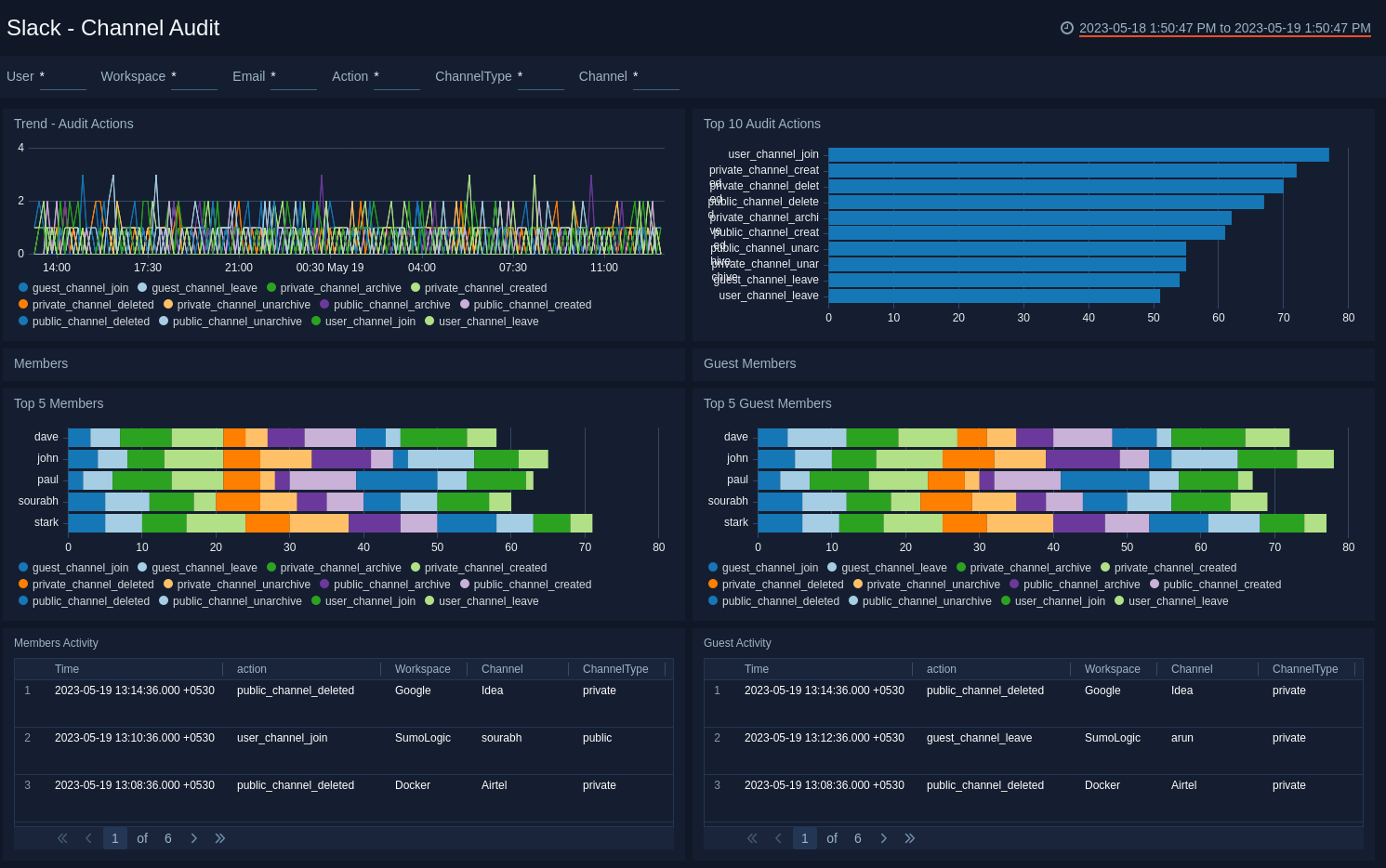
File and App Audit
The Slack - File and App Audit dashboard displays file audit and app audit information. The panels show audit actions, top actions and file types or scopes, top users, and member activity.
Use this dashboard to:
- Monitor all application and file related activities across multiple workspaces.
- Identify the top users who perform actions related to applications and files.
- Identify all guests and members that share, install applications download and upload files across public and private channels.
- Identify the top scopes under which applications are approved and installed.
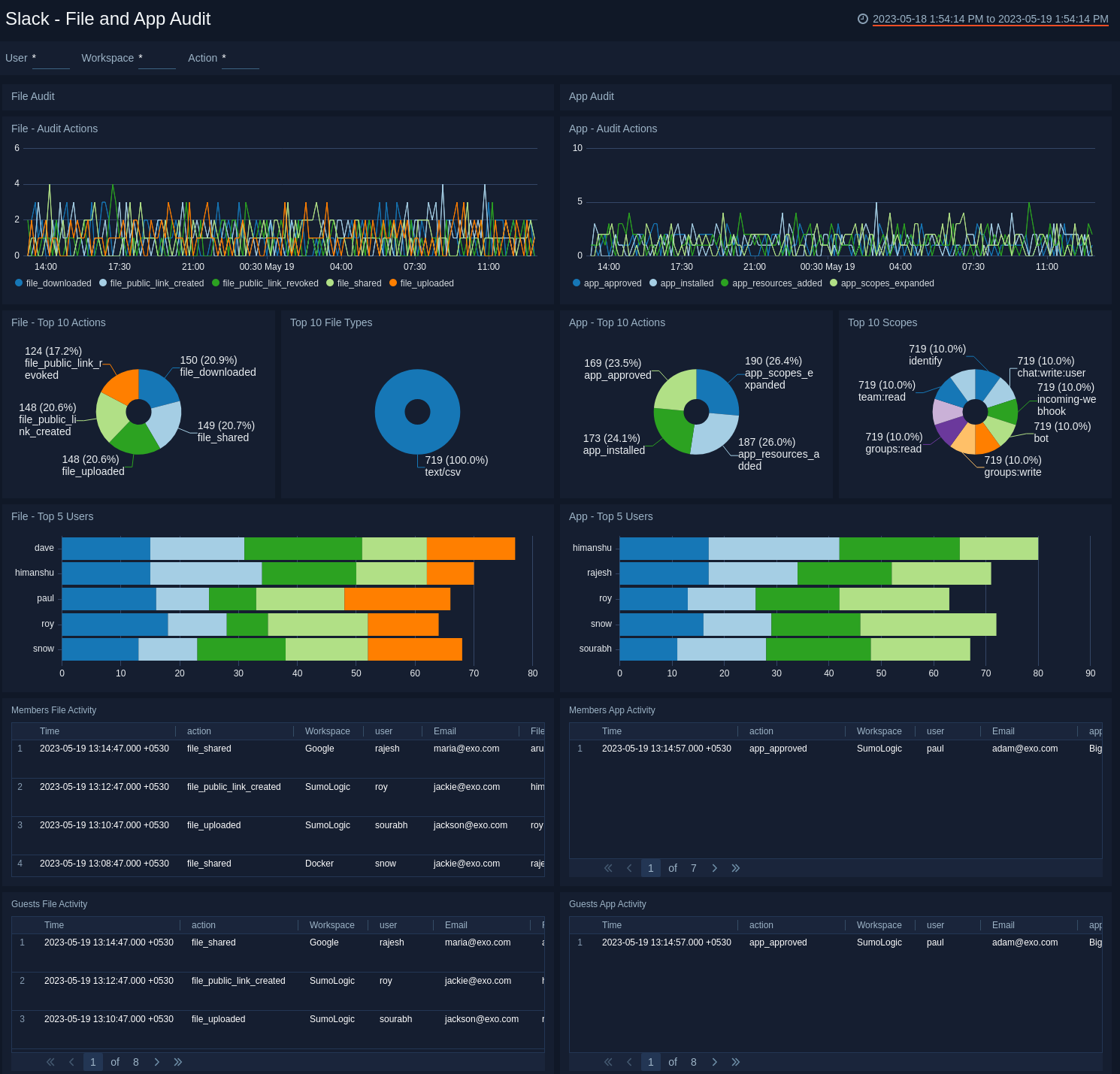
Upgrade/Downgrade the Slack app (Optional)
To update the app, do the following:
Next-Gen App: To install or update the app, you must be an account administrator or a user with Manage Apps, Manage Monitors, Manage Fields, Manage Metric Rules, and Manage Collectors capabilities depending upon the different content types part of the app.
- Select App Catalog.
- In the Search Apps field, search for and then select your app.
Optionally, you can identify apps that can be upgraded in the Upgrade available section. - To upgrade the app, select Upgrade from the Manage dropdown.
- If the upgrade does not have any configuration or property changes, you will be redirected to the Preview & Done section.
- If the upgrade has any configuration or property changes, you will be redirected to the Setup Data page.
- In the Configure section of your respective app, complete the following fields.
- Field Name. If you already have collectors and sources set up, select the configured metadata field name (eg _sourcecategory) or specify other custom metadata (eg: _collector) along with its metadata Field Value.
- Click Next. You will be redirected to the Preview & Done section.
Post-update
Your upgraded app will be installed in the Installed Apps folder and dashboard panels will start to fill automatically.
See our Release Notes changelog for new updates in the app.
To revert the app to a previous version, do the following:
- Select App Catalog.
- In the Search Apps field, search for and then select your app.
- To version down the app, select Revert to < previous version of your app > from the Manage dropdown.
Uninstalling the Slack app (Optional)
To uninstall the app, do the following:
- Select App Catalog.
- In the 🔎 Search Apps field, run a search for your desired app, then select it.
- Click Uninstall.